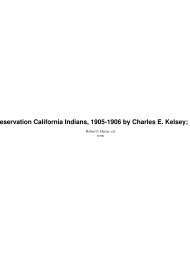Pathways: A Story of Trails and Men (1968), by John W ... - Yosemite
Pathways: A Story of Trails and Men (1968), by John W ... - Yosemite
Pathways: A Story of Trails and Men (1968), by John W ... - Yosemite
- No tags were found...
Create successful ePaper yourself
Turn your PDF publications into a flip-book with our unique Google optimized e-Paper software.
“Savage went to Horseshoe Bend to get a group together to go after the Indians. While he was gone, his store at the junction <strong>of</strong> the AguaFria <strong>and</strong> Mariposa was attacked, his assistant killed, his goods stolen, <strong>and</strong> his squaws carried <strong>of</strong>f.“On January 13, 1851, Governor MacDougal wrote to Sheriff Burney, the Sheriff <strong>of</strong> all Mariposa County, authorizing him to mustera force <strong>of</strong> men for the protection <strong>of</strong> lives <strong>and</strong> property in Mariposa County. The comm<strong>and</strong> with commission <strong>of</strong> Major was <strong>of</strong>fered toSavage, <strong>and</strong> the men formed into three companies. The entire Battalion was composed <strong>of</strong> about 200 men <strong>and</strong> thereafter became knownas the now famous Mariposa Battalion.“Savage drilled the Mariposa Battalion at the Lewis Ranch about 15 miles southwest <strong>of</strong> the Agua Fria on the Mariposa Creek, until onFebruary 16, 1851, when Governor MacDougal ordered all military activity ceased until peaceable means <strong>of</strong> reconciling the Indianscould be tried.“A Federal Commission then endeavored to persuade the tribes <strong>of</strong> the Sierra south <strong>of</strong> the Stanislaus River to come in <strong>and</strong> talk peace.Only the friendly ones reported. When the warring tribes <strong>of</strong> the Mariposa region failed to appear at a feast <strong>and</strong> council scheduled forthem at Fremont’s Ranch on the Mariposa River, the Mariposa Battalion was given orders to bring them in <strong>by</strong> force. They left the LewisRanch on their now famous expedition, on March 19, 1851.“The expedition went up Mariposa Creek, passed Savage’s ruined store at the junction <strong>of</strong> the Mariposa <strong>and</strong> the Agua Fria, <strong>and</strong> turned<strong>of</strong>f toward the Chowchilla Mountains. It followed through the mining camps <strong>of</strong> Bootjack <strong>and</strong> Usona to Wawona. From Wawona theywent down the south fork <strong>of</strong> the Merced River to Bishop Creek.“Savage <strong>and</strong> the Companies <strong>of</strong> the Mariposa Battalion completely surprised about 1,000 Nuchu Indians at a place called Bishop’s Campat the fork <strong>of</strong> Bishop Creek <strong>and</strong> the Merced River, who readily agreed to the terms <strong>of</strong> the Commissioners. Nuchu runners were then sentout to the other tribes, threatening them with severe reprisals if they did not come in <strong>and</strong> surrender like the Nuchus.“One <strong>of</strong> the runners reached the <strong>Yosemite</strong>s with this message <strong>and</strong> on March 23, 1851, Tenaya, Chief <strong>of</strong> the <strong>Yosemite</strong>s, the mostrecalcitrant <strong>of</strong> all the chieftains, stood at the edge <strong>of</strong> Savage’s camp in dignified silence until bidden entry. Suspicious at first but finallyappearing won over, Tenaya departed to bring in the rest <strong>of</strong> his people. The next day he returned to say that his tribe was coming in,but that since the trails were full <strong>of</strong> deep snow, it would take time to bring in the men, women, <strong>and</strong> children. This seemed reasonable,but <strong>by</strong> the next day when none had shown themselves, Savage figured that the crafty Tenaya had actually ordered his people to gohigher into the mountains.‘By the strange <strong>and</strong> humorous means <strong>of</strong> a foot race, which incidentally included Indians, Savage selected 57 men to follow after Tenaya<strong>and</strong> the <strong>Yosemite</strong>s. This bizarre foot race served the purpose <strong>of</strong> warming up the men, providing excitement for the Indians still in thevicinity, <strong>and</strong> perhaps most importantly, insuring the fleetness <strong>of</strong> the 57 volunteers.“The volunteers ascended the divide to the east <strong>of</strong> Bishop’s Camp, progressing slowly in deep snow. In midafternoon they met 72<strong>Yosemite</strong>s heading for Savage’s Camp. Tenaya explained this was all that had come <strong>and</strong> that the rest had fled to the Tuolumne, <strong>and</strong> tothe Monos across the Sierra Nevada. Knowing the <strong>Yosemite</strong>s were a large tribe, Savage sent Tenaya <strong>and</strong> the 72 Indians to his camp<strong>and</strong> pressed on, following the Indians trail in the snow.“After more than an hour’s march, they reached a promontory in the vicinity <strong>of</strong> Old Inspiration Point, <strong>and</strong> from this spot across fromMajestic El Capitan, late in the afternoon <strong>of</strong> March 27, 1851, the awestruck Major Savage <strong>and</strong> his men had revealed to them the fullglory <strong>of</strong> <strong>Yosemite</strong> Valley.“They camped that night at the foot <strong>of</strong> Bridalveil Falls <strong>and</strong> then discussed a name for the Valley. Unaware <strong>of</strong> the beautiful Indianname Ahwahnee, meaning “deep grassy valley”, [Editor’s note: For the correct origin <strong>of</strong> the word Ahwahnee see “Origin <strong>of</strong> the Word<strong>Yosemite</strong>.”—dea] the men voted to name it after the tribe <strong>and</strong> called it <strong>Yosemite</strong>.“This concludes our discovery story except to tell that after several days <strong>of</strong> exploration in the Valley, one aged squaw was discovered,<strong>and</strong> through the negligence <strong>of</strong> some <strong>of</strong> the soldiers, Tenaya <strong>and</strong> most <strong>of</strong> the <strong>Yosemite</strong>s were allowed to escape.“On July 1, 1851, the Mariposa Battalion was mustered out. Major Savage resumed his trading operations in a store on the Fresno Rivernear Coarse Gold. Savage engaged again in trading <strong>and</strong> in cattle ranching. Bad blood had sprung up between him <strong>and</strong> some <strong>of</strong> the settlersalong King’s River. He was fearless <strong>and</strong> felt the security from danger at the h<strong>and</strong>s <strong>of</strong> those he disliked, which he expressed in seeminglycareless but purposeful disdain <strong>and</strong> contempt. Among those toward whom he thus felt was Major Harvey, then the County Judge <strong>of</strong>Tulare. He had spoken foully <strong>of</strong> Harvey, <strong>and</strong> his language had been reported to that gentleman, August 16, 1852. Savage visited King’sRiver Reservation, where William Campbell, whom he also disliked, was agent. Judge Marvin <strong>of</strong> Tuolumne was there present withMajor Harvey. The latter asked Savage if the reported language had been uttered <strong>by</strong> him, <strong>and</strong>, on Savage responding that it was correctlyreported, Harvey dem<strong>and</strong>ed its retraction. Savage’s only response was a slap in the face, <strong>and</strong> at that instant his pistol dropped from hisloose shirt bosom. Harvey instantly drew his pistol <strong>and</strong> fired with fatal effect. Savage fell dead. An examination before a neighboringjustice <strong>of</strong> the peace ended in Major Harvey’s immediate release, as it was held that he had acted in clear self-defense.“The remains <strong>of</strong> Major Savage were at the time buried near where he fell. In 1855, they were removed <strong>by</strong> Dr. Leach, his firm friend <strong>and</strong>at one time his business partner, <strong>and</strong> given permanent sepulture at the point on Fresno River known as “Leach’s old store,” which hadalso been Savage’s trading post. Doctor Leach erected over the spot a granite monument, ten feet high, square <strong>and</strong> massive <strong>and</strong> stern,typical <strong>of</strong> the robust form <strong>and</strong> the sturdy spirit <strong>of</strong> the strange <strong>and</strong> strong man whose memory it commemorates, <strong>and</strong> upon one <strong>of</strong> its sidesis carved simply his name. He sleeps the everlasting sleep in the enduring, rock-bound bed in the middle <strong>of</strong> the stream on whose bankshe last dwelt, <strong>and</strong> its gentle murmurings in placid flow, <strong>and</strong> its wild turbulence when lashed <strong>by</strong> angry winds, are alike as the calmness<strong>and</strong> the passionate moments <strong>of</strong> his lifetime, the lulla<strong>by</strong> <strong>of</strong> his peaceful rest, <strong>and</strong> the wierd threnody <strong>of</strong> his violent end.” 1________1 Quotations are from a letter <strong>and</strong> speech <strong>by</strong> Kenneth J. Fryer, at the dedication <strong>of</strong> a plaque in honor <strong>of</strong> James D. Savage. This plaqueis located at the new Inspiration Point right near the eastern entrance to the Wawona Tunnel.


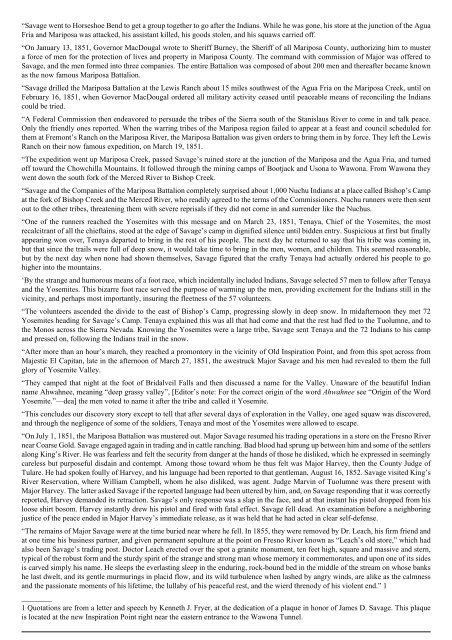

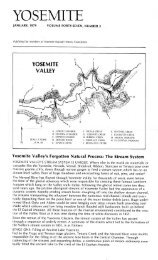
![(March 1982) [PDF] “We Are Pleased to Announce†- Yosemite Online](https://img.yumpu.com/51299748/1/190x242/march-1982-pdf-aeuroewe-are-pleased-to-announceaeur-yosemite-online.jpg?quality=85)
![[PDF] Old Horny, Yosemite's Unicorn Buck - Yosemite Online](https://img.yumpu.com/51269869/1/184x260/pdf-old-horny-yosemites-unicorn-buck-yosemite-online.jpg?quality=85)
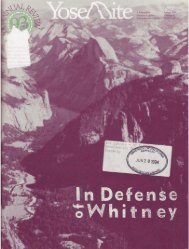
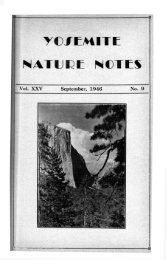
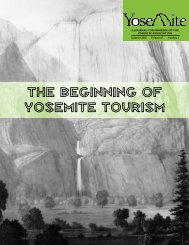
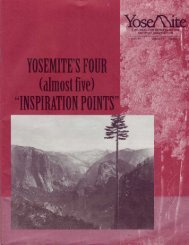
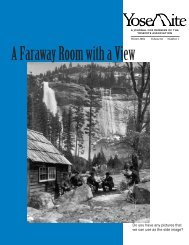
![1985 [PDF] - Yosemite](https://img.yumpu.com/48128837/1/184x260/1985-pdf-yosemite.jpg?quality=85)

